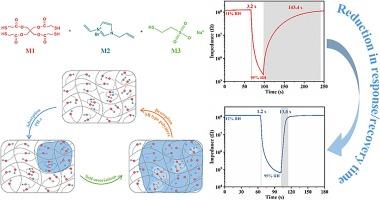部分两性离子聚液体在湿度传感器中的应用。
IF 9.7
1区 化学
Q1 CHEMISTRY, PHYSICAL
引用次数: 0
摘要
近年来,聚电解质已成为高性能湿度传感器的敏感材料。如何获得快速恢复和高灵敏度的聚电解质湿度传感器是一个巨大的挑战。本文制备了一种由两性离子聚合物(部分两性离子聚合物)修饰的聚离子液体湿度传感器(PZPILs)。在不同的湿敏工艺条件下,PZPILs可以在PILs和两性离子聚合物之间转换。在水分子的吸附过程中,pzpil的特性与pil相似。在解吸水分子时,PZPILs的特性趋向于磺基甜菜碱(SB)型两性离子聚合物的特性。该设计赋予了湿度传感器高响应和快速响应/恢复的特性。优化后的PZPILs传感器在11% ~ 95%的相对湿度(RH)范围内具有较高的响应速度(4862.8),响应/恢复时间(1.0 s/15.0 s)短,湿度滞后较小,约为0.6% RH。PZPILs将PZPILs湿度传感器的恢复时间从143.4 s缩短到15.0 s,并提高了PZPILs的响应速度(从1980.8 s提高到4862.8 s)。本文章由计算机程序翻译,如有差异,请以英文原文为准。

Application of partially zwitterionic poly(ionic liquid)s in humidity sensors
Polyelectrolytes have shown promise as sensitive material for high-performance humidity sensors in recent years. How to obtain fast recovery and high sensitivity polyelectrolyte humidity sensors is a great challenge. A kind of poly(ionic liquid)s (PILs) humidity sensors modified by zwitterionic polymers (partially zwitterionic PILs, named PZPILs) were prepared in this work. The PZPILs can transform between PILs and zwitterionic polymers in different humidity sensitive processes. In the adsorption process of water molecules, characteristics of PZPILs are similar to those of PILs. When desorbing water molecules, the characteristics of PZPILs trend to those of sulfobetaine (SB) type zwitterionic polymers. This design endowed the humidity sensors high response and fast response/recovery characteristics. The optimized PZPILs sensor shows high response (4862.8) in a wide relative humidity (RH) range of 11 %–95 %, with short response/recovery time (1.0 s/15.0 s) and small humidity hysteresis about 0.6 % RH. The PZPILs shortened the recovery time of the PILs humidity sensors (from 143.4 s to 15.0 s), and improved the response (from 1980.8 to 4862.8).
求助全文
通过发布文献求助,成功后即可免费获取论文全文。
去求助
来源期刊
CiteScore
16.10
自引率
7.10%
发文量
2568
审稿时长
2 months
期刊介绍:
The Journal of Colloid and Interface Science publishes original research findings on the fundamental principles of colloid and interface science, as well as innovative applications in various fields. The criteria for publication include impact, quality, novelty, and originality.
Emphasis:
The journal emphasizes fundamental scientific innovation within the following categories:
A.Colloidal Materials and Nanomaterials
B.Soft Colloidal and Self-Assembly Systems
C.Adsorption, Catalysis, and Electrochemistry
D.Interfacial Processes, Capillarity, and Wetting
E.Biomaterials and Nanomedicine
F.Energy Conversion and Storage, and Environmental Technologies

 求助内容:
求助内容: 应助结果提醒方式:
应助结果提醒方式:


